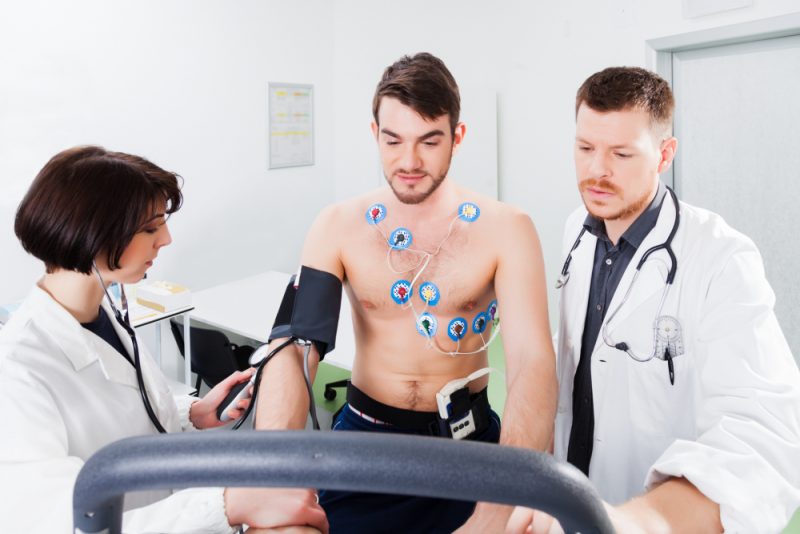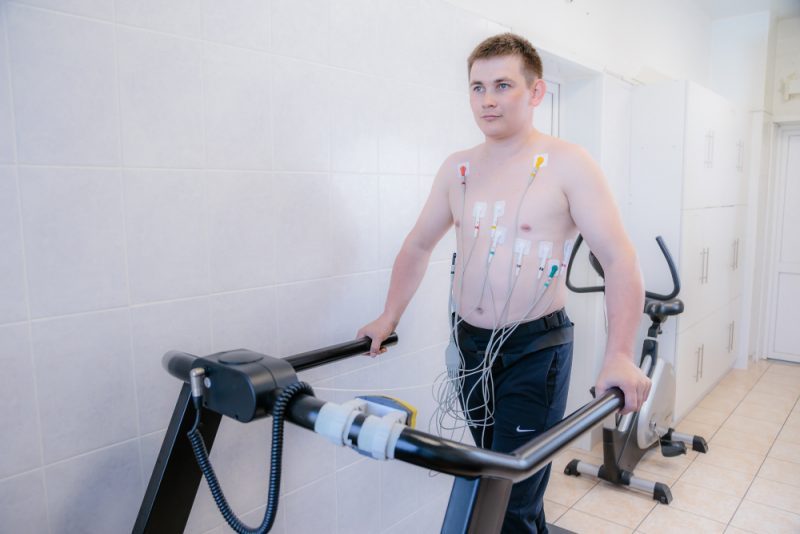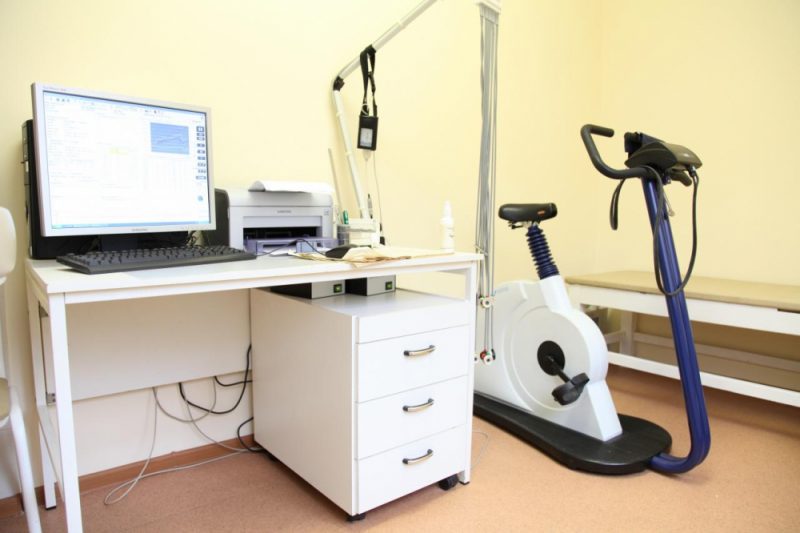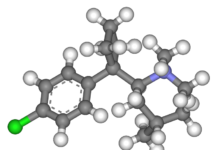Heart disease is still leading the list of fatal pathologies. It is important to detect the disease in time and start treatment in order to avoid negative consequences. Since ischemia often proceeds secretly and asymptomatically, cardiologists rely on the results of diagnostic examinations, one of which we will consider. Treadmill test - what is it and why is it considered indispensable for recognizing hidden ischemic conditions?
Material Content:
What is a treadmill test
The myocardium provides uninterrupted blood flow to all cells of the body. As a result, they receive oxygen and substances necessary for life. Oxygen is also needed by the heart muscle for uninterrupted operation. Coronary heart disease (CHD) is one of the consequences of its lack. The progression of the disease can lead to a heart attack.
The treadmill test in cardiology helps to identify oxygen deficiency and myocardial malfunction. This is a stress test, which consists in examination on a treadmill. It is based on limited physical activity to detect cardiographic signs of pathologies of the heart muscle.
Throughout the procedure, changes are recorded in the ECG, blood pressure (BP) and heart rate (HR).
Sometimes the removal of an electrocardiogram is combined with stress echocardiography.
Pros of the treadmill test:
- Ease of execution.
- Non-invasiveness and absence of risks for the examined person.
- Diagnostic accuracy.
- The ability to recognize pathologies at the initial stage.
The examination allows you to diagnose ischemia and other diseases in the early stages. The ECG is taken before testing, during activity on the track and after it.
Indications for use in cardiology
This diagnostic method is indicated for the following group of patients:
- People engaged in socially significant activities (drivers of passenger buses, pilots of civil airlines, drivers). Representatives of these professions pass the test after reaching 40 years.
- Patients suffering from hypertension.
- Patients with diabetes.
- Persons with a tendency to obesity.
- Smokers.
- People over 40 years old who have a complicated surgical intervention.
- Patients suffering from ischemic heart disease.
Preparation and procedure for conducting the survey
Preparation for the treadmill test begins the day before it is carried out and is divided into several stages.
Preparation stages
The following instructions must be followed:
- Stop taking drugs that affect heart rate and heart rate, sedatives.
- Limit smoking and coffee.
- 3-4 hours before the examination, you need to have breakfast. Just before the test, eating is not recommended. Fluid intake is not limited.
- Prepare comfortable athletic shoes for the examination.
It is very important to comply with all requirements. This will affect the accuracy of the results.
Inspection Procedure
A referral to the study can be obtained at the cardiologist’s office or hospital. Immediately before the treadmill test, the patient must undergo an examination by a therapist. In the office of functional diagnostics, the nurse takes an ECG, records blood pressure and the frequency of myocardial contractions, and if necessary, the doctor performs an echocardiography.
Electrocardiograph sensors are fixed on the chest, shoulders, collarbone and back of the patient. The tonometer cuff is fixed above the elbow.
The examinee rises to the treadmill, takes a comfortable position and starts walking. Blood pressure and heart rate are continuously recorded. The cardiologist sees the dynamics of changes in real time. Thus, the doctor immediately notices the slightest disturbance in the rhythm of cardiac activity.
In stages, the nurse changes the angle of the treadmill and accelerates the pace, dosing increasing physical activity.
Research is carried out until the patient experiences discomfort. If the doctor sees a significant change in the readings on the electrocardiogram, he can prematurely stop the procedure.
Blood pressure and ECG are recorded for another 8 minutes after exercise, then the doctor decrypts the results.
The total test duration is about 30 minutes.
Deciphering the results
When a cardiologist interprets the results of the examination, he takes into account the following features:
- Walking speed.
- The position of the treadmill.
- The degree of physical fitness of the subject.
- Blood pressure and ECG dynamics.
- The period required to normalize all indicators after exercise.
What may be the result is reflected in the table.
| Positive | On the cardiogram there are changes characteristic of IHD and other myocardial pathologies. The patient complains of deterioration. |
| Doubtful | On the cardiogram, prerequisites for ischemia were found. |
| Negative | Cardiogram without pathological changes. The subject does not complain of well-being. |
| Uninformative | The examination was terminated at the insistence of the patient. There is no pathology on the ECG, blood pressure and heart rate are within normal limits. |
Negative test value
The doctor calculates the maximum allowable heart rate based on the individual data and parameters of each patient. If during diagnosis the maximum heart rate was reached, but there were no discomfort and changes on the ECG, the examination is completed.The test result is considered negative. The patient has no signs of ischemia and other pathological changes in the myocardium, therefore, he does not need therapy.
Contraindications
This type of examination is considered safe, but nevertheless there are diseases in which the test is contraindicated. These conditions include: acute cardiac pathology, MI, stroke, unstable angina. Diseases of infectious etiology, accompanied by fever, are also a reason for refusing to conduct an examination. It is also not recommended to take a test for patients with decompensated gastrointestinal diseases, patients with bronchial asthma, patients with exacerbations of cholecystitis, pancreatitis, osteoarthritis. In the presence of relative contraindications, the decision on the advisability of passing the treadmill test is made by the doctor.
Likelihood of complications
Throughout the study, the doctor monitors the patient’s heart performance and, if the slightest disturbance occurs, can stop the procedure and provide necessary assistance. For this reason, the risk of complications can be minimized.
What is the difference between treadmill test and bicycle ergometry
Both methods are similar in that they are aimed at accelerating the heart rate to a certain frequency and are used to diagnose myocardial diseases. For the treadmill test, use a treadmill, with bicycle ergometry - an exercise bike.
The mode on the treadmill is gentle, so it is prescribed for the following group of patients:
- Patients with joint diseases.
- Overweight persons.
- To old people.
Since the principle of the procedure is similar, the doctor explains to the patient the features of the treadmill test, what kind of examination it is, and they together choose the method of its conduct.
Exercise tests are considered one of the most effective methods for diagnosing ischemic conditions. If the cardiologist sees the testimony for the test, you should not refuse it. Responsible attitude to your health prolongs life and improves its quality.
















